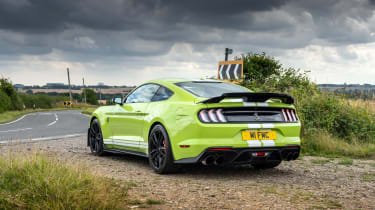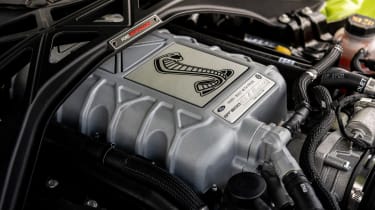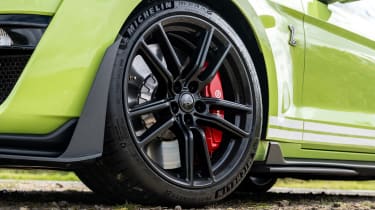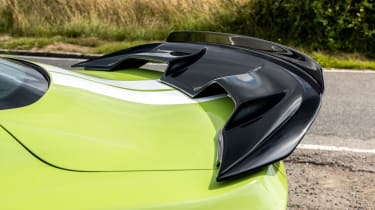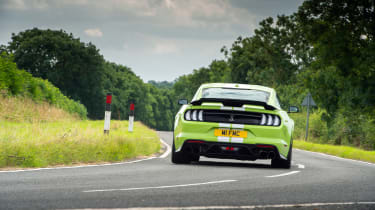Ford Mustang Shelby GT500 UK review – how does Ford’s maddest muscle car handle Blighty?
Loud and crass, and yet paradoxically sophisticated, the GT500 is unremittingly brilliant
Let’s talk context for a swift moment, because when it comes to cars and Britain the notion of a chartreuse Ford Mustang with stripes, a supercharger and 750bhp sitting in a Waitrose car park is about as in line with the norm it would be to find a panda sitting quietly on a pew in Westminster Abbey. There’s immediately something special about a Mustang in the UK, and when it’s a GT500 – the one deemed literally too loud, too dirty and too extreme to be considered for European homologation by Ford itself – that factor rises tenfold.
Stanced like a ’90s touring car, it looks completely different to a standard Mustang GT, and while they can be a little cumbersome to drive, its bombastic muscle car image still appeals. But it’s always been the US-only Shelby models, first the (now-discontinued) GT350 and now this GT500, which have been the most intriguing of this Mustang generation, and not so much for their ultimate power but their resolute focus on dynamics and engagement – which we so often need to remind most big OEMs are two very different things.
So what’s special about the latest Shelby GT500? Well, lots, starting with the aptly named ‘Predator’ 5.2-litre V8 engine that’s based on the ‘Voodoo’ unit used by the GT350, but ditches the flat-plane crank for a more traditional cross-plane unit mostly to handle the huge 2.65-litre Roots-type supercharger that’s inverted on top of it. The Voodoo’s uprated internals have been brought across too, with larger and stronger forged con rods and high-flow cylinder heads. All these changes not only liberate extra power, but also 625lb ft of torque.
More reviews
In-depth reviews
Reviews
- Ford Mustang Dark Horse 2025 review – the last of a dying breed
- Ford Mustang GT 2024 review – old school in all the right ways
- Ford Mustang Mach-E GT 2023 review – it’s fast, but is it fun?
- Used Ford Mustang (Mk6, 2015 to date) review and buyer’s guide
- Ford Mustang Mach 1 2021 review – America’s BMW M4 gets track fit
- Ford Mustang Steve McQueen Bullitt Edition 2021 review – a 720bhp tribute act
> Dodge Challenger Hellcat Redeye review
Ford made a conscious decision to only fit the GT500 with an automatic transmission (contrasting the GT350’s compulsory six-speed manual), but rather than staying in-house with its sticky ten-speed torque converter, Ford Performance made the decision to source a seven-speed dual-clutch from Tremec instead, despite the ten-speed technically being able to handle its tremendous torque figure. Drive is then run through a carbonfibre propshaft to the limited-slip differential.
So far, the changes seem in-keeping with the muscle car norm by adding copious amounts of power and torque. But unlike most other muscle cars, these technical changes are only just the start of Ford’s comprehensive upgrade package, because far more attention has been paid to the chassis.
To start, open the bonnet and, yes, you’ll find a huge supercharger, but also a new composite front crash structure, behind which sits an entirely bespoke front axle and geometry set-up. This substantial change in construction has allowed Ford’s engineers to do all sorts of things to the GT500’s set-up, including the fitting of bespoke aluminium wheel hubs, installing more negative camber to promote a far more direct and accurate steering rack.
The front track width is identical to that of the GT350, but the 500’s whopping 11-inch-wide front wheels on 305-section tyres have required extra liberation from the front wings, so they’re bespoke, too. Sticking with the wheels, they’re also now up another inch in diameter to 20 inches in order to fit a colossal set of 420mm steel brake discs with six-piston Brembo calipers up front.
The rear subframe has also been fiddled with, featuring stiffer mounting points and opposingly coiled springs that make each side of the rear axle symmetrical. There’s also stiffer bushes throughout the suspension front and rear, and the dampers are those excellent MagneRide units which use metallic filings in the damper fluid which react in milliseconds in alteration of their compression and rebound rates.
Yet as any backyard tuner will know, putting big hardware on a Mustang doesn’t always make for a great performance car. But boy have Ford’s engineers worked some magic, because when a 750bhp powertrain doesn’t dominate the experience, the chassis must be pretty special. And it is.
Yes, the GT500 is brutally quick, and when the ‘Track’ exhaust mode is selected I can’t think of another road car that’s louder, but the cohesion between its steering, brakes, throttle, transmission and differential feels expertly honed. The steering is the first big win over what you’d find in a normal Mustang, as while not full of feel, it’s incredibly direct and trustworthy. This is especially impressive when you consider the 610mm of Pilot Sport 4 S rubber the steering arms have to control, not forgetting the aggressive negative camber and toe-in Ford’s engineers dialled into the set-up.
Yet on the move it’s this direct interaction with the steering that gives you the confidence to start exploring the GT500’s incredibly deep box of tricks. As speeds rise, so does the steering weight, loading with transparency and relaying precisely how much grip the front axle can give you. And it’s a lot – the front end on this car is insane, and it’s extrapolated by the Shelby’s quicker steering rack.
Start to lean on it and you also realise the body control is superb, with impressive lateral stability balanced out by enough roll to help the chassis communicate how much grip the car has left to give at both ends. Yes, at 1825kg it’s a heavy beast, but with so much grip, so much go and so much stopping power, it’s totally within the realms of controllability. It’s now that your confidence grows and liberties can start being taken with the powertrain. With so much grunt you’d imagine it impossible to drive with real vigour on short notice, yet all the chassis elements extinguish any apprehension about using all 750bhp – it’s the most unreal feeling. The long throttle pedal, not unique to just this Mustang, is crucial here to help meter out your power delivery, while the differential’s consistency and the rear axle’s superb resilience to lateral movement gives you incredible traction.
It’s now that the GT500 is at its most engaging – you begin testing it, prodding it, seeing how much you can get away with before things start to feel like they’re getting out of hand, and yet any time you want to retreat you realise the colossal brakes and superbly judged electronic stability control systems are there to back you up.
The dual-clutch now comes into its own, too – it’s responsive, predictable and completely unobstructive when it comes to getting power to the road. At this point, you find yourself ripping through the gears towards a bend at full tilt, braking harder, turning in with more aggression, getting on the power earlier and earlier, the throttle, transmission and differential dishing out bhp to the precise amount you ask for. That’s just beyond that point of adhesion, when the rear axle tells you through the seat (which is still just a tad high) that it’s about to give way and the steering lightens ever just so to let you know it’s on its tippy-toes.
Now you don't notice the width, or even the noise. Instead you’re totally engrossed in one of the most engaging and enthralling experiences in the car business, and crucially one that feels completely unique to this very special car. The motoring world is full of fascinating performance cars, but the best ones always transcend the machine, leaving just the experience with you.
It uses a lot of fuel (like a lot), the CO2 rating is appalling, it’s unsociably loud in its silly exhaust mode and the interior’s still crap, but where the thrill of driving is concerned there are few that do it quite like the Shelby GT500 Mustang.
Prices and rivals
Did we mention you can’t officially purchase a GT500 in the UK? Importers and backstreet vendors will be happy to get one over, but it’ll be a left-hooker, and probably in the realms of £135,000 by the time you get it here, not including taxes. In the US, its price is closer to the cost of an M4 Competition, or about £55,000. It makes for tough reading, doesn’t it?
As a result, while an M4 is still dynamically superior, it’s a very different car. A Dodge Challenger Hellcat might initially appeal on similar metrics, but it’s totally outclassed by the GT500, and Chevrolet’s love-hate relationship with the Camaro has left a super-high-performance variant at a loss for the moment, despite past hits with the ZL1.


